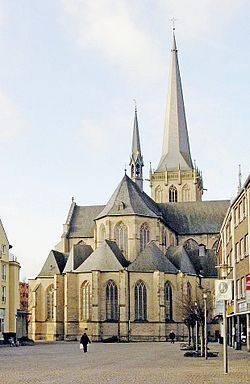Wesel | |
|---|---|
 Willibrordi-Dom in Wesel. The cathedral, dedicated to St Willibrord, has been restored after wartime bombing. | |
Location of Wesel within Wesel district  | |
| Coordinates: 51°39′31″N 6°37′4″E / 51.65861°N 6.61778°E | |
| Country | Germany |
| State | North Rhine-Westphalia |
| Admin. region | Düsseldorf |
| District | Wesel |
| Subdivisions | 5 |
| Government | |
| • Mayor (2020–25) | Ulrike Westkamp[1] (SPD) |
| Area | |
| • Total | 122.617 km2 (47.343 sq mi) |
| Elevation | 23 m (75 ft) |
| Population (2022-12-31)[2] | |
| • Total | 61,330 |
| • Density | 500/km2 (1,300/sq mi) |
| Time zone | UTC+01:00 (CET) |
| • Summer (DST) | UTC+02:00 (CEST) |
| Postal codes | 46483, 46485, 46487 |
| Dialling codes |
|
| Vehicle registration | WES, DIN, MO |
| Website | www |
Wesel (German pronunciation: [ˈveːzl̩] ⓘ) is a city in North Rhine-Westphalia, Germany. It is the capital of the Wesel district.
Wesel is situated at the confluence of the Lippe River and the Rhine.
Suburbs of Wesel include Lackhausen, Obrighoven, Ginderich, Feldmark, Fusternberg, Büderich, Flüren and Blumenkamp.
The city originated from a Franconian manor that was first recorded in the 8th century. In the 12th century, the Duke of Clèves took possession of Wesel. The city became a member of the Hanseatic League during the 15th century. Wesel was second only to Cologne in the lower Rhine region as an entrepôt. It was an important commercial centre: a clearing station for the transshipment and trading of goods.

In 1590 the Spanish captured Wesel after a four-year siege. The city changed hands between the Dutch and Spanish several times during the Eighty Years War. In 1672 a French force under Louis II de Bourbon, Prince de Condé captured the city. Wesel was inherited by the Hohenzollerns of the Margraviate of Brandenburg in 1609 but they were unable to take control of Wesel until the Treaty of Nijmegen in 1678. Although the city had been heavily fortified the Prussians evacuated the city during the Seven Years' War and it was occupied by the French. It was returned to Prussia at the end of the war. Friedrich Wilhelm von Dossow was the Prussian Governor of Wesel during the 18th century. Wesel was ceded to the French in 1805 under the Treaty of Schönbrunn. The French heavily fortified the city constructing a rectangular fort called the Citadelle Napoleon at Büderich and the Citadelle Bonaparte on an island in the Rhine off Wesel. Though blockaded by the Allies in 1813 the city remained in French hands until after the Battle of Waterloo. After the Napoleonic Wars of the early 19th century, the city became part of the Prussian Rhine Province and the Citadelle Napoleon was renamed Fort Blücher.

During World War II, as a strategic depot, Wesel became a target of Allied bombing. Air raids, using impact and air-burst bombs, on 16, 17, 18 and 19 February 1945, destroyed 97% of the town. The Wehrmacht blew up bridges along the Rhine and Lippe to prevent Allied forces from advancing. The Wehrmacht also destroyed the 1,950m-long railway bridge, the last Rhine bridge remaining in German hands, on 10 March. On 23 March, Wesel came under the fire of over 3,000 guns when it was bombarded anew, in preparation for Operation Plunder. The shelling was assisted by a raid of RAF bombers and a larger raid that night, during which ten individual bombers each dropped a 10,000 kg bomb on Wesel at 2100 hours. Before the town was finally taken by Allied troops, 97% of its structures were destroyed. In the ensuing attacks by Allied forces, the town was taken with minimal casualties. Operation Varsity – the largest airborne landings of the war – dropped 18,000 troops into the area to take the hills behind Wesel. The British 1st Commando Brigade was already attacking Wesel, carried into action by LVT Buffalos. The remainder of the Allied force crossed the Rhine in more amphibious vehicles.
From almost 25,000 in 1939, the population was reduced to 1,900 by May 1945.[3] In 1946 Wesel became part of the new state North Rhine-Westphalia of West Germany.
Wesel's mayors:
Since 1945:
There is a railway station in the city centre as well as Wesel-Feldmark, about 2 km north. The stations are served by trains to Oberhausen, Duisburg, Düsseldorf, Cologne, Arnhem (Netherlands), and Mönchengladbach.[5] A small diesel-only connecting railway line goes to Bocholt also, there are plans to electrify it.

One of Germany's highest radio masts is situated in the district of Büderich on the left bank of the Rhine. The Wesel transmitter measures 320.8 metres in height.